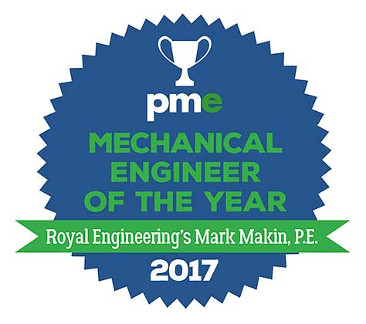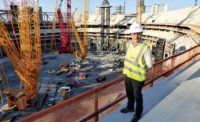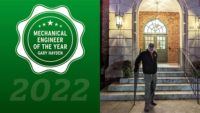
Congratulations to this year’s pme Mechanical Engineer of the Year: Mark Makin, P.E., of Royal Engineering.
You can go home again. Mark Makin, P.E., knows that to be true.
The 21-year veteran mechanical engineer returned to Provo, Utah-based Royal Engineering after a one-year stint with another firm.
“This is the only company I’ve worked for twice,” he states. “If it wasn’t great, that wouldn’t happen because the other company I worked for I wouldn’t go back. Not even for double the money.”
Today, Makin leads Royal Engineering’s growing mechanical department that handles the commercial, institutional, industrial and multifamily residential applications in the burgeoning Utah markets. Makin’s desire to understand new technologies, his technical expertise and leadership at Royal Engineering helped earn him earn pme’s 2017 Mechanical Engineer of the Year honors.
An initial spark
Makin spent the first six years of his career as an electrical engineer with Royal, but a well-intentioned “bribe” by the firm’s previous owner got the Brigham Young graduate to flip to the mechanical engineering side of the industry.
“He said, ‘Here’s your current pay. If you get your mechanical bachelor’s degree, this would be your future pay,’” Makin recalls.
Makin became Royal Engineering’s first mechanical engineer in 2002 and began to work on developing his team. There was talent available in the market and Makin sought out strong drafters and helped groom the new recruits where he could.
“I was able to teach them what I needed them to do and I picked up the slack where they couldn’t cover,” he notes. “Now that we’ve grown as a company, we can bring in people that have prior experience.”
Today, Makin’s team at Royal Engineering spans from people relatively fresh out of college to nearly 30-year veterans.
“We enjoy taking the experience they have, looking at what we have and deciding if we need to make a change to utilize some of their knowledge and experience to make our company better,” Makin notes.
Makin recalls those years when his mechanical department was in its infancy and it was stretched thin, forcing himself to work an absurd amount hours to cover the workload. Now, with 18 employees — two with their P.E. license, four working toward their P.E. license and 12 designers and project managers — in Royal’s Provo and Sandy, Utah, offices, the team can comfortably handle even more work.
“The last five years, we’ve averaged 300 to 400 projects per year,” he states.
Delivering the goods
Makin has partnered with Pascal Meyer, A.I.A., and principal architect with Sandy-based Carpenter Stringham Architects, on projects for more than 10 years. Their teams have worked on a diverse portfolio of facilities including health-care, retail and office buildings.
Meyer says Makin introduced VRF technology to Carpenter Stringham Architects years ago and it has been a go-to design since that day. He says Makin excels at educating not just himself, but the building owners as well.
“He has a consistent knowledge and knows what best suits the building,” Meyer says. ‘They have paid consistently good attention to our projects.”
Meyer adds: “Royal Engineering’s personnel has been consistent and their communication is great.”
Meyer confirms business is booming in Utah, the local economy is strong but good labor is limited. He adds developers are seeing an opportunity and a demand for housing, thus having Makin and Royal Engineering at his side has been vital.
“Royal Engineering’s work speaks for itself,” Meyer declares. “They consistently deliver.”
Precision design
One of the major projects Makin and Royal Engineering have undertaken is the two-floor, 41,000-square-foot Ogden Medical Clinic in Ogden, Utah. The facility features 48 exam rooms, 17 procedure rooms, and can handle MRIs, CT scans, sleep exams, hearing exams, and allergy and skin analysis.
Makin had to meet the expectations of personal comfort for the medical professionals working at the facility. Makin and his team designed Ogden Medical with VRF split up into six zones. During a meeting with all the brass, Makin noted each room could be its own zone, but it would cost a certain amount of money per room. The medical people went through the floor plan knowing which doctor would be in what room and how he or she would want their exam room to feel.
“The difficulty became physically putting the products in the ceiling because everyone wanted to avoid hallway noise,” he says. “I have lighting experience and I know a unit can’t occupy the same location as a light, grill and so forth.
“If that wasn’t enough, there were whole building exhaust, compressed air, and wet- and dry-vac systems in the facility. And since it’s a medical building there had to be smoke zones, requiring barriers through the two floors throughout the building to get smoke compartments small enough.
“We were able to make it work. Thank goodness it was a good installer. He was able to take a concept and make it work in the field.”
Makin and Royal Engineering started the design on the facility in late 2012 and it sprawled into early 2013. Construction was completed in 2015 and Makin is proud of the work because it gave him a great opportunity to teach a new member of his mechanical team.
“I had a brand-new designer with no experience I was directing through this project. That made it extra enticing,” he recalls.
Makin notes Ogden Medical has opened more avenues for work with the building owners and developers, which he takes to heart.
“This is just the engineer side of me. I don’t want to physically call someone up and say, ‘Hey, how are you enjoying your building?’” he says. “For us, the payoff is when they say we have another building we want you to work on. After this job, we did another 15,000-square-foot addition to another one of their properties, which I had initially done the work on.
“To me, that means they’re still happy. They still keep working with us. The same architect, the same engineers. That’s the payoff for us.”
Helping hand
The support Royal Engineering provides Makin and his team does not go unnoticed. Makin says the firm is starting to get into fire-protection design and will provide whatever is necessary for the staff to get properly trained.
“We’ve told the engineers, you decide what you need,” he says. “If you need to physically take classes, we’ll send you and we’ll pay for that. If you need books, manuals, codes, if you need webinars, you tell us what you need and we’ll take care of it. It’s so we can facilitate the training needed. It’s going to benefit the company so we’ll just do it quick. We’ll pay for it and take care of it.
“The firm encourages our continuing education. We have approval for one of our supply houses to do a tradeshow in our office.”
Makin gives the others in the mechanical department space to learn and grow as engineers. He’ll step in when needed to help solve a problem, but wants the staff to learn by doing. Makin will visit the Sandy office once a week and is easily accessible by email or phone. He’s instilled a protocol that every voicemail and email message must be answered in 24 hours.
“That’s something I’ve learned from past coworkers, just how to treat people and from past bosses how not to treat people,” he says. “You need to let people know you got the message and you need to respond to it.”
Trust the process
Makin and his wife have four children and seven cars in the garage. The cars are Makin’s hobby and the garage is his sanctuary. The beat-up 1968 Pontiac Firebird he purchased in 1982 for peanuts and restored to glory has maybe 85,000 miles on it in 35 years. All the time working on it has helped Makin stay sharp and has taught him a couple lessons he’s brought to Royal Engineering.
“I monitor 18 people,” he notes. “I have found that the people who work on cars have a spatial recognition of where things are and how they work together. So we have quite a few people where cars are their hobby.
“The people who have pure school learning and book learning don’t always get it. They’re really smart with numbers, but they don’t get it. They don’t understand how an electrical panel can’t be in the same place as the water heater. Some of the kids these days, that’s something they never learned. It needs to look nice on paper.”
Ask Makin where he sees himself in five to 10 years and he knows it’ll be right behind his current desk in Provo, continuing to evolve and improve Royal Engineering’s mechanical department.
“I’ll be here to continue to improve our process and teach new people in the industry,” he states.
As for where the industry will be at that time, Makin knows energy efficiency will continue to dominate trends and technologies. But, it’s his job to make sure those efficiencies are right for his design, the client and the application.
“The industry will keep getting pushed and be more efficient, and it’s going to reach a point when cost will begin to slow the push for efficiency,” he says. “In 2015, we helped architects with their insulation on their building. They pushed residential from R38 to R49 in the attic in one code change. That’s a high percentage and leakage. The last round of the IECC in 2015, they said it was going to add either $1,500, or $5,000 to each home. You know we’re building thousands of homes. We don’t deal with them, but we deal with the insulation impact on apartments.”
Engineering has been a part of Makin’s life since he started fixing his bicycle at age seven, to the buildings that cover Utah and the other 17 states he’s licensed in, to those cars he works tirelessly on when he has a free moment. Makin isn’t punching a timeclock twice a day, he lives and breathes engineering.
“I told my wife that engineering, it’s not a degree. It’s not an occupation. It’s a lifestyle,” he says.
“She assures me that it’s a disorder.”






